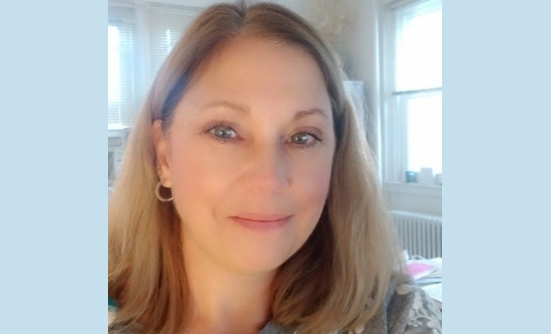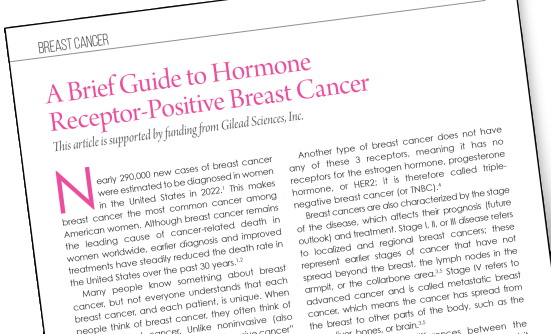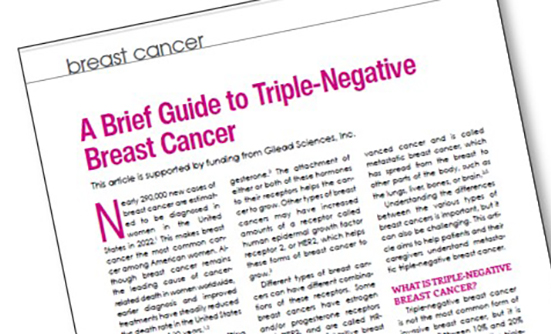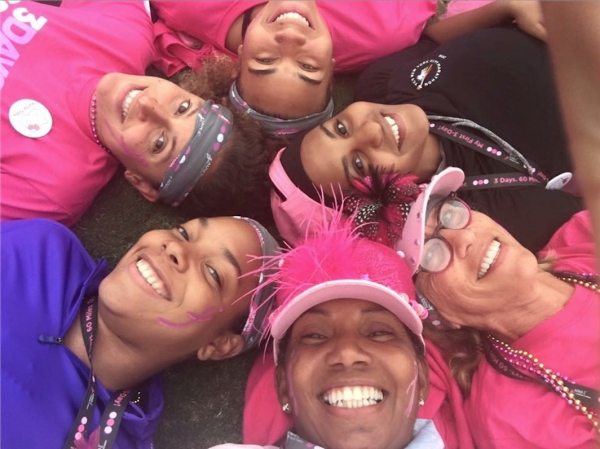
On a sunny Saturday in March, TOUCH Talk (an online support group for black breast cancer survivors) met for the first time. Valarie, with her honeyed, reassuring voice and her calming energy, led a guided meditation to root her fellow breasties in the virtual space they shared. Everyone closed their eyes and grounded themselves in the moment with deep, steady breaths.
“Imagine that you are lying on a beach and the warmth of the sun is healing you completely—your mind, your body, your spirit. Say to yourself ‘everything is well’ as the sun warms you. You’re at peace. You’re among your breasties. You’re safe.”
After everyone’s eyes had fluttered back open, Valarie Worthy, MSN, RN, introduced herself to the group—a 21-year breast cancer survivor, nurse navigator at the Duke Cancer Institute, and co-founder of TOUCH, The Black Breast Cancer Alliance.
When Valarie asked if anyone had a survivorship plan, only 1 woman nodded.
I’d never heard of that until I met you, chimed in Ricki Fairley, survivor and co-founder of TOUCH.
Valarie waited a beat. There had to be more. The rest of the women on the screen looked at her quietly, waiting for her explanation.
The silence gave her concrete answers to the questions she wondered about every day in her role as a patient navigator: Are patients getting connected to the things they need to get connected to? Do they know what questions to ask?
Valarie realized what she really already knew to be true from decades of all too similar conversations with black breasties (a term of endearment among breast cancer survivors): No one had talked to these women about exercise, about diet. No one had answered their questions about vitamins and supplements or how to talk to their family members about their cancer. No one asked these women how they learned best, so as to better explain their diagnosis and treatment to them in the first place.
These black survivors were not just from rural, underresourced areas either; they dotted progressive urban areas too. California, Texas, New York, DC, Denver, North Carolina, Florida. These were women seeking out support groups, women active in the online black breast cancer community, women who wanted guidance and advocacy. They still had not received a survivorship plan or even the basic resources of navigation.
“If you listen to news, cancer rates are going down. But a lot of black women are still dying. With all of the technology that we have, how are we missing this?” Valarie asks, exasperated. “How are people going into a hospital and still not having their needs met? Why aren’t we making a difference with all of the people and resources that we have? Somehow, that needle should have moved.”
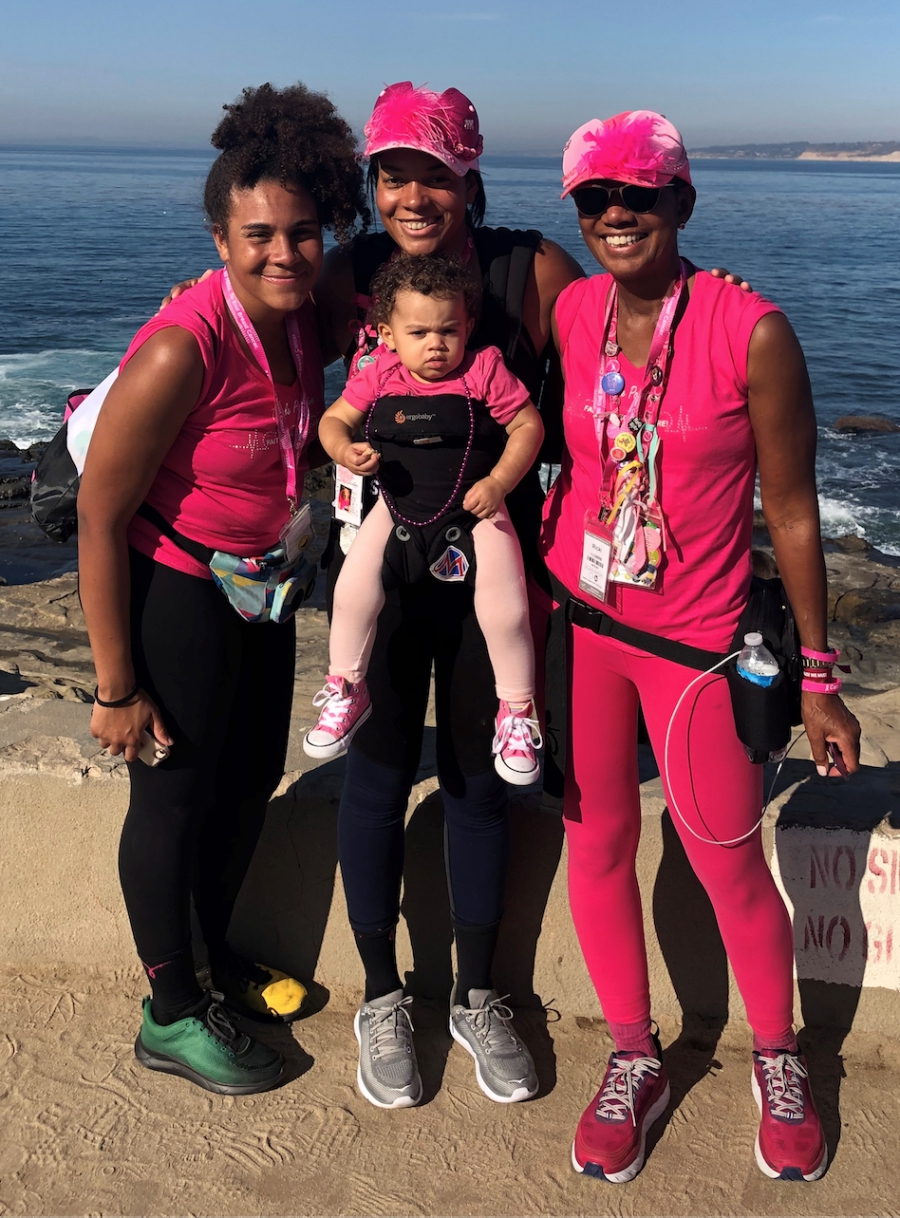
The History of Navigation Is the History of Black Breast Cancer
Patient navigation began with black breast cancer.
When Harold P. Freeman, MD, started at the Harlem Hospital Center in New York City in 1979, he noticed that the black breast cancer patients—most of whom were poor and at least half of whom did not have medical insurance—were being diagnosed at a late stage of disease and were dying at an alarmingly high rate.
In fact, from 1964 to 1986, the Harlem Hospital Center treated 606 breast cancer patients who fit this description. Only 6% of those women were diagnosed with early-stage breast cancer.1 The 5-year survival rate of the women was 39%.1
Dr. Freeman witnessed firsthand the ways that poor, uninsured black women faced barrier after barrier: financial insecurity, poor health literacy, communication barriers, social injustice and institutionalized racism, and emotional barriers such as mistrust and fear. These barriers inordinately delayed black women’s breast cancer treatment and cost them their lives.
When Dr. Freeman started the first patient navigation program at the Harlem Hospital Center in 1990, he envisioned a model that would “diminish the extremely high breast cancer death rate in a population of poor black women” by eliminating barriers, shortening delays in care, and incorporating free or low-cost preventive breast cancer screening.2 Over time, those disturbing numbers began to shift. Early-stage cancer diagnosis increased significantly, and the 5-year survival rate jumped to 70%.2
Now, there are 71 National Cancer Institute–designated cancer centers and more than 1500 Commission on Cancer–accredited cancer programs across the United States. They all require that cancer patients have access to a navigator.
Falling Through the Cracks
At its very inception, navigation was meant to reduce health disparities and improve health outcomes for black women by tackling barriers to their care. But here in 2021, the national disparities in breast cancer statistics haven’t budged as much as Dr. Freeman’s initial navigation program predicted.
Why, more than 30 years later, are black women still experiencing disproportionate delays in care?3 Why are black breast cancer patients still diagnosed at later stages of disease, and why is their relative risk of death 71% higher than the risk of white women?4,5
Black breast cancer patients still have the lowest 5-year survival rate of any race or ethnicity.6 The younger the breast cancer patient, the wider the disparity. Black breast cancer patients under 40 have a 68.4% 5-year survival rate, whereas white breast cancer patients under 40 have an 85.2% 5-year survival rate.4
Beyond 5-year survival rates, the relative risk of recurrence for black breast cancer patients is a staggering 39% higher than for white breast cancer patients.7
“To me, it’s kind of crazy in a way,” says Valarie, shaking her head. “That term, that concept, was born out of African American women presenting at his Harlem clinic with late-stage cancer. Since then, it has supposedly grown and now it’s the thing.” She air quotes for emphasis. “Why is it, then, that the people who really were the catalyst, if you will, for navigation aren’t benefiting from it? When it started as a result of them?”
Realizing the Promise of Navigation
We know that navigation makes the biggest difference for black patients, who experience the greatest delays in care.8 So why aren’t we seeing that positive impact reflected in the statistics for black breast cancer patients?
A 2018 Patient Navigation in Medically Underserved Areas study published in Cancer found that black women, women living in poverty, and women who reported high levels of distrust of the healthcare system were the least likely to report barriers and therefore were less likely to receive additional support.9
Black women are superwomen. They support themselves, their families, and their communities without fail. Considering that 77.3% of black mothers are single moms, they don’t have time to sit around thinking about what the world will offer them or how other people could lighten their load.10 Because black women take care of everything without complaint, they don’t have much practice admitting they might need help.
But Dr. Freeman’s patients didn’t have to ask for help. As their doctor, he observed and anticipated their needs with his very first navigation program. Ultimately, “it is a responsibility of that cancer center to have strategies in place to target underserved populations that otherwise would not ask for care. It is not the responsibility of the patient,” Valarie affirms. “When somebody’s diagnosed with cancer, why should they worry about someone assisting them? That should already be part of the plan. Somebody ought to catch them at every touchpoint. Every single touchpoint.”
While it’s up to cancer centers and navigators to support patients who need it most, black breast cancer patients cannot afford to wait another 30 years for health parity. Until medical institutions catch up to Dr. Freeman’s vision, advocates and advocacy organizations like TOUCH, The Black Breast Cancer Alliance will continue to push institutions to do better by their black breast cancer patients.
Black Breasties, Ask These 5 Questions
In the meantime, black breasties deserve the tools to advocate for themselves. If you aren’t given a navigator, ask for one. And if you are paired with a navigator, ask for what you need. Breast cancer is hard enough without having to shoulder extra burdens.
Not sure what to ask for? Valarie not only sits and talks with cancer patients every day, but she survived black breast cancer. Here are the top 5 questions she wishes black breast cancer patients would ask their navigators:
1. What is your role? What can you help me with?
Throughout your cancer treatment and even after, it’s important to clearly define the roles of your medical team (and your support team). According to Valarie, asking your navigator about their role early on “ensures that both the patient and the navigator understand the role of that navigator so you don’t have unrealistic expectations of this individual, and the navigator has a clear understanding of what that patient needs.”
2. What services does your cancer center offer during treatment? What services or resources do they offer after I am done with treatment?
Some services can be expected at all cancer centers: interpreters; support groups; individual, couple, or family counseling; palliative and pain care; genetic counseling; and information on clinical trial opportunities.
But check with your navigator, because a lot of resources are specific to each center. For example, many centers offer free legal services, help with transportation, temporary housing support, and childcare. Others offer yoga or meditation, exercise consultations and physical therapy, dietitians or nutritionists who can help with breast cancer–specific nutrition (including what foods can help with side effects, cooking classes, meal plan help, and recipes), and sexual health services. Duke, where Valarie works, even offers pet therapy during appointments and treatments.
Most cancer centers also offer resources for caretakers and family members of patients, so don’t forget to ask about services for your loved ones too!
3. Are there community organizations that offer additional free or low-cost services for patients?
Outside of the cancer center, your local community will also have specific, unique services that your navigator can direct you toward, such as spiritual support, childcare, or transportation aid. National groups, such as the American Cancer Society, have a wealth of information to support breasties with everything from local support groups to free wigs. TOUCH is always available to assist patients in getting connected to valuable resources.
4. What survivorship information do you have when my cancer is done? Are there places where I can get more information in addition to what I hope my oncologist will give me?
“The first questions every patient asks after treatment are ‘How can I keep this from coming back?’ ‘Is there anything else I can take?’ You feel like a moving target.”
The Commission on Cancer requires that its centers offer a survivorship plan at the end of a patient’s treatment. Your survivorship plan should be personalized, with information about the specific treatments you were on or will remain on (and any long-term side effects), as well as lifestyle things like exercise, diet, and stress.
Beyond your survivorship plan, though, your navigator should be able to suggest sources (community or otherwise) where you can reach out for support around rebuilding and reimagining your best life after treatment, ask questions as they arise, and get help navigating your new normal.
5. Could you repeat that? Could you explain that again in a different way?
“So many times, I’ve been in rooms with patients and the doctor has explained everything and said, ‘Do you have any questions?’ They shake their heads no. ‘Well, I’ll step out a minute, and I’ll bring some literature back.’ The minute the doctor walks out that door, the patient looks at me and says, ‘What did he say?’”
Stop your provider when you don’t understand something and ask for clarification. Your doctor and navigator are both there to make sure that you know what is happening inside your own body. You can’t make the best choices for yourself without clear, complete information.
If your navigator doesn’t ask you what your learning style is, tell them anyway. That way, they can tailor their explanations to the way your brain understands information (videos, visuals, handouts, etc).
As Valarie tells her patients: “The squeaky wheel gets the oil.”
And don’t stop your self-advocacy there! Reach out to TOUCH at touchbbca.org or through our Facebook page—we are always here for you.
Agents of Empowerment and Change
Patient-centered at its core, patient navigation assists patients with challenges that may prevent them from receiving care. Although a diagnosis of cancer may be frightening, no patient should feel alone or devoid of resources. Every cancer patient should be equipped with the necessary tools to make informed decisions before, during, and after treatment.
Through education and empowerment, patient navigators like Valarie are making real, tangible change in the lives of black breasties.
“You can’t prepare someone for a cancer diagnosis. You just can’t. But you can arm them with tools that can help them put 1 foot in front of the other,” Valarie says. “As navigators, we’ll try our best to give patients every tool in our arsenal to have healthy and productive lives.”
Emily Powers is a Health Storyteller for TOUCHBBCA.

Tips from TOUCH
What Is Black Breast Cancer?
Black breast cancer is a different and distinct disease that requires special attention and focus from the breast cancer ecosystem.
- Black women are 42% more likely to die of breast cancer1
- Black women younger than 35 years get breast cancer at 2 times the rate of white women and die at 3 times the rate2
- Average participation by black women in breast cancer clinical trials overall is less than 3%.3
To learn more, visit touchbbca.org!
Bring a Buddy!
You might not remember everything that was said in your appointment—that’s okay. Just remember to bring a trusted friend or family member to be your eyes and ears. They can write down important points the doctor makes, ask follow-up questions, and help to identify your needs with the navigator.
Want to Learn More?
Join us live every Wednesday at 6 PM on Face book.com/BlackDoctor.org for “The Doctor Is In,” a web series that tackles topics in black breast cancer through conversations with breastie guests and breast cancer experts.
References
- American Cancer Society Cancer Action Network. Disparities in Breast Cancer: African American Women. www.fightcancer.org/sites/default/files/FINAL%20-%20Disparities%20AABreastCancer%2002.14.17%20.pdf. 2017. Accessed April 29, 2021.
- Anders CK, Johnson R, Litton J, et al. Breast cancer before age 40 years. Semin Oncol. 2009;36:237-249.
- Linden HM, Reisch LM, Hart A Jr, et al. Attitudes toward participation in breast cancer randomized clinical trials in the African American community: a focus group study. Cancer Nurs. 2007;30:261-269.
References
- Freeman HP, Rodriguez RL. History and principles of patient navigation. Cancer. 2011;117(15 Suppl):3539-3542.
- Freeman HP. The origin, evolution, and principles of patient navigation. Cancer Epidemiol Biomarkers Prev. 2012;21:1614-1617.
- Emerson MA, Golightly YM, Aiello AE, et al. Breast cancer treatment delays by socioeconomic and health care access latent classes in black and white women. Cancer. 2020;126:4957-4966.
- Baquet CR, Mishra SI, Commiskey P, et al. Breast cancer epidemiology in blacks and whites: disparities in incidence, mortality, survival rates and histology. J Natl Med Assoc. 2008;100:480-488.
- Sparano JA, Brawley OW. Deconstructing racial and ethnic disparities in breast cancer. JAMA Oncol. 2021;7:355-356.
- SEER Explorer. National Cancer Institute. Surveillance, Epidemiology, and End Results Program. https://seer.cancer.gov/explorer. Accessed April 29, 2021.
- Black women have higher risk of recurrence than other ethnicities. Oncology Times. 2019;41(1):24.
- Ko NY, Snyder FR, Raich PC, et al. Racial and ethnic differences in patient navigation: results from the Patient Navigation Research Program. Cancer. 2016;122:2715-2722.
- Kim SJ, Glassgow AE, Watson KS, et al. Gendered and racialized social expectations, barriers, and delayed breast cancer diagnosis. Cancer. 2018;124:4350-4357.
- Camarota SA. Births to Unmarried Mothers by Nativity and Education. Center for Immigration Studies. https://cis.org/Camarota/Births-Unmarried-Mothers-Nativity-and-Education. 2017. Accessed April 29, 2021.








